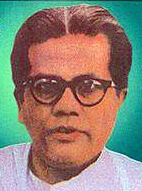Indira Goswami, popularly known as Mamoni Raisom Goswami or Mamoni Baideo among Assamese people, was one of the most influential figures in Indian literature. A poet, writer, professor, and editor, she left an everlasting impact on Assamese Literature and Indian literary culture. She was the first Assamese writer to receive the prestigious Jnanpith Award, making her a legendary figure in the literary world.
Early Life and Education
Born on 14 November 1942, Indira Goswami hailed from a Brahmin family in Guwahati, Assam. Her father, Umakanta Goswami, and mother, Ambika Devi, provided her with a nurturing environment that encouraged her literary talents. She completed her early education at Latashil Primary School and Pine Mount School in Shillong, which was then the capital of undivided Assam. Later, she passed her H.S.L.C from Tarini Charan Girls’ School in 1957. Her passion for literature led her to Cotton College in Guwahati, where she majored in Assamese literature.
Journey into Literature
Indira Goswami’s journey as a writer began at an early age. She was encouraged by Kirti Nath Hazarika, who published her first short stories in a literary journal when she was just 13 years old. This early recognition fueled her passion for writing, and from that point onward, there was no looking back.
Her literary works are deeply personal and often reflect her struggles. She suffered from depression since childhood and even mentioned in her autobiography, The Unfinished Autobiography, about her thoughts of jumping into Crinoline Falls near her home in Shillong. Her life took a tragic turn after her husband, Madhaven Raisom Ayengar, died in a car accident just 18 months after marriage. This led her into a phase of deep depression, making her dependent on sleeping pills. To cope with her grief, she joined Goalpara Sainik School as a teacher before moving to Vrindavan, Uttar Pradesh, where she began her research and writing in search of inner peace.
The Rise of a Literary Legend
Mamoni Raisom Goswami once stated that she wrote to survive—her literature became an outlet for her emotions and experiences. Her writing focused on the struggles of the marginalized sections of society, women’s oppression, and the untold stories of Assamese culture.
Her experiences in Kashmir and Madhya Pradesh, where her husband worked as an engineer, were reflected in her novels Ahiron and The Chehnab’s Current. She also explored issues like patriarchy and widowhood in Assamese Brahmin families, challenging social norms through her bold writing.
Major Literary Works
Indira Goswami wrote numerous novels, short stories, and poems, many of which became classics of Assamese literature. Some of her most celebrated works include:
- The Moth-Eaten Howdah of a Tusker (Datal Hatir Une Khowa Howda) – A powerful novel that examines the life of Brahmin widows in Assam.
- Pages Stained With Blood (Tej Aru Dhulire Dhusarita Prishtha) – A novel set against the backdrop of the 1984 anti-Sikh riots in Delhi.
- The Man from Chinnamasta (Chinnamastar Manuhto) – A bold critique of religious practices in Assam.
- The Rusted Sword (Mamore Dhora Tarowal) – A novel highlighting social injustice and women’s struggles.
- Uday Bhanu – A touching story depicting human resilience.
Her short stories like Hridoy, Nangoth Sohor, and Borofor Rani also received widespread acclaim.
Breaking Social Barriers
Mamoni Raisom Goswami was a fearless writer who challenged social norms and taboos. Born in a conservative Brahmin family, she defied tradition by marrying outside her community and addressing sensitive topics like widowhood, oppression, and patriarchy in her works.
In her novel Une Khowa Howda (The Saga of South Kamrup), she tells the story of a young Brahmin widow, Giribala, who dares to break social norms by secretly eating meat. This was a radical narrative at the time and showcased her courage as a writer.
Contribution to Peace Negotiations
Apart from literature, Indira Goswami played a crucial role in peace negotiations between the United Liberation Front of Asom (ULFA) and the Indian government. She acted as a mediator, leading to the formation of the People’s Consultative Group (PCG). Although she called herself an “observer” rather than a mediator, her efforts were instrumental in initiating peace talks. ULFA later elected her as a PCG member, recognizing her role in the process.
Awards and Recognition
Indira Goswami’s contributions to literature and society earned her numerous awards, including:
- Sahitya Akademi Award (1982) – For Mamore Dhora Tarowal.
- Jnanpith Award (2000) – The highest literary honor in India.
- Asam Sahitya Sabha Award (1988)
- Bharat Nirman Award (1989)
- Katha National Award for Literature (1993)
- Padma Shri (2002) – She declined this honor.
- Prince Claus Award (2008)
- Krishnakanta Handique Award (2009)
Final Years and Legacy
Indira Goswami spent the later years of her life battling health issues. Despite her illness, she continued to contribute to Assamese literature and social causes. She passed away on 29 November 2011 at the age of 70 after prolonged illness.
Her legacy, however, remains alive through her literary works, which continue to inspire generations of writers and readers.
Conclusion
Mamoni Raisom Goswami was not just a writer; she was a voice for the voiceless. Her bold narratives, emotional depth, and fearless approach to storytelling make her one of India’s greatest literary icons. Whether it was her novels, short stories, or peace initiatives, her impact was far-reaching and unforgettable. Today, her works are studied in universities, cherished by readers, and celebrated as an integral part of Assamese and Indian literature.
Her contributions will forever be remembered, proving that literature has the power to challenge norms, initiate change, and give a voice to those who need it the most.
FAQ’s:
Q 1. Who was Indira Goswami, and why is she famous?
Indira Goswami, also known as Mamoni Raisom Goswami, was a celebrated Assamese writer, professor, and social activist. She won the Jnanpith Award, India’s highest literary honor, for her contributions to literature. Her works focused on the struggles of marginalized people, women’s rights, and social reforms.
Q 2. What are some of Indira Goswami’s most famous books?
Some of her most notable works include The Moth-Eaten Howdah of a Tusker, Pages Stained with Blood, The Chenab’s Current, and The Man from Chinnamasta. These books explore themes like social oppression, caste struggles, and the impact of violence on society.
Q 3. What role did Indira Goswami play in peace talks between ULFA and the Indian government?
She acted as a mediator between the banned militant group United Liberation Front of Asom (ULFA) and the Indian government. Her efforts led to the formation of the People’s Consultative Group, which aimed to negotiate peace in Assam.
Q 4. How did Indira Goswami’s personal struggles influence her writings?
She faced depression from a young age and struggled with suicidal thoughts. The sudden loss of her husband further deepened her pain. Writing became her way of coping with life’s hardships, and her works often reflected themes of grief, suffering, and resilience.
Q 5. What awards did Indira Goswami receive for her literary contributions?
She won several prestigious awards, including the Sahitya Akademi Award, the Jnanpith Award, the Padma Shri (which she declined), and the Principal Prince Claus Award. These honors recognized her impact on Indian literature and society.
Q 6. How did Indira Goswami challenge societal norms through her writings?
Coming from a conservative Brahmin family, she broke many traditional barriers. Her books openly discussed issues like widowhood, caste discrimination, and women’s oppression. Through her bold storytelling, she brought attention to deep-rooted social injustices.
Q 7. Where did Indira Goswami work as a professor?
She served as the Head of the Assamese Department at the University of Delhi. During her time there, she produced some of her most influential literary works and mentored many students.
Q 8. What is The Moth-Eaten Howdah of a Tusker about?
This novel portrays the struggles of Assamese Brahmin widows who were bound by strict societal rules. It highlights how women in traditional families suffered due to rigid customs and social expectations.
Q 9. Did Indira Goswami write about historical and religious themes?
Yes, she wrote extensively on religious and historical subjects. Her research on the Ramayana, Ramayana from Ganga to Brahmaputra, explores regional variations of the epic. She also wrote about the socio-political impact of temple practices and religious beliefs in India.
Q 10. When did Indira Goswami pass away, and what was her legacy?
She passed away on November 29, 2011, after a prolonged illness. Her legacy lives on through her powerful writings, social activism, and contributions to Assamese and Indian literature. Her works continue to inspire readers and scholars worldwide.












